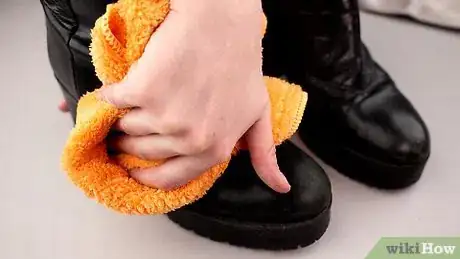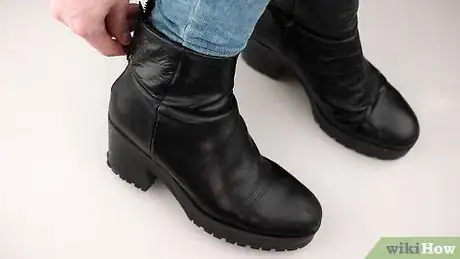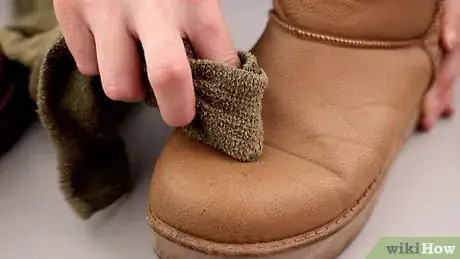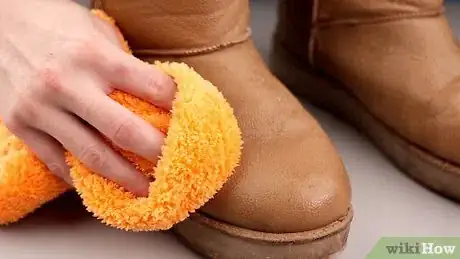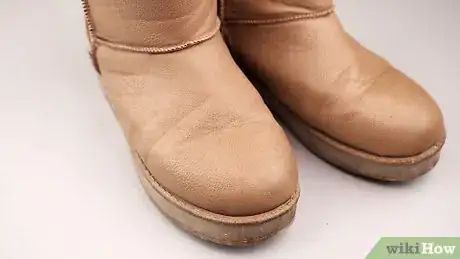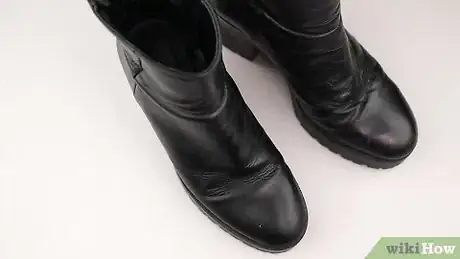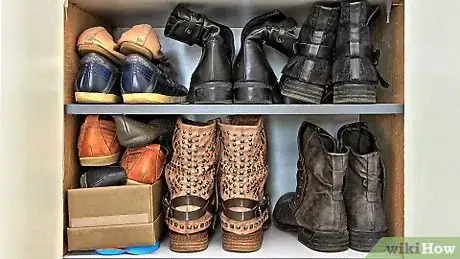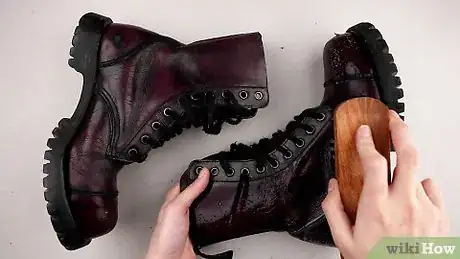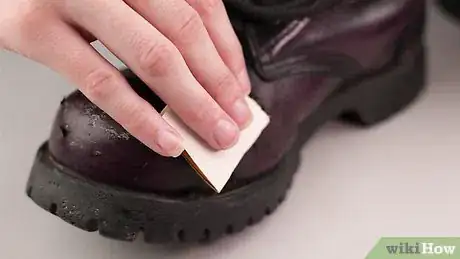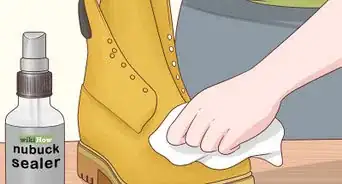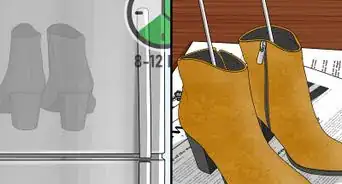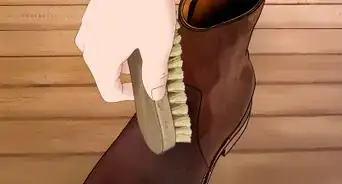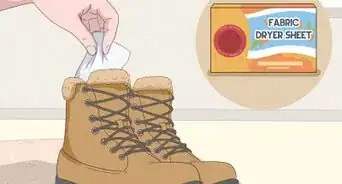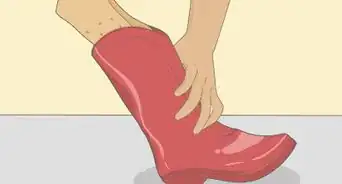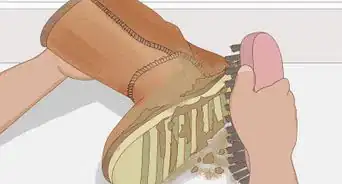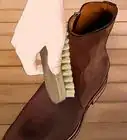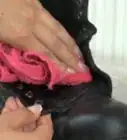This article was co-authored by Mallika Sharma. Mallika Sharma is a Certified Leather Care Technician and the Founder of The Leather Laundry, a niche spa service for luxury leather gear in India. Mallika specializes in leather cleaning, coloring, repairing, and restoring for shoes, handbags, jackets, wallets, belts, and sofas. She holds a Master’s degree in Finance and Investment from the University of Edinburgh Business School. Mallika is a certified Professional Leather Care Technician and trained with the globally reputed leather care company, LTT in the United Kingdom.
There are 15 references cited in this article, which can be found at the bottom of the page.
This article has been viewed 44,343 times.
Who doesn’t love a good pair of leather boots? Leather is a super versatile and sturdy material that can be fashionable, functional, or both! But cracks in the leather can ruin their appearance and potentially lead to rips and tears. Because leather is a natural material, it can dry out and crack if it’s exposed to heat or if it isn’t properly maintained. Fortunately, there’s plenty you can do to help keep your boots from cracking and repair minor cracks if they do form.
Steps
Keeping Leather Boots Clean
-
1Brush off dirt and dust with a soft, dry brush or cloth. Make sure you brush along the seams and creases as well as any cracks in the leather. Really work to get as much dust and dirt as you can off of the boots.[1]
- Use a soft-bristled brush so you don’t scrape or damage the leather.
-
2Wash off stubborn dirt and grime with saddle soap and a nylon brush. Saddle soap is specially designed for cleaning leather.[2] If you’ve got some caked-on dirt or stubborn spots of grime, apply some saddle soap and use a nylon brush to gently scrub the surface of the leather clean.[3]
- You can find saddle soap at leather goods stores and shoe stores.
- If you don't have any saddle soap, you can use lukewarm water and a little bit of a mild soap, like baby soap. Dampen a cloth with the soapy water and rub it across the surface of the leather, then dry the boots with a clean cloth.[4]
Advertisement -
3Polish your boots by wiping them with a shine cloth. After you clean the leather, take a premium shine cloth and wipe the leather in a circular motion to give it a good polish. Wipe the entire surface of the leather so it’s evenly and properly moisturized.[5]
- Look for shine cloths at shoe stores or leather supply shops. You can also order them online.
-
4Remove creases from patent leather with castor oil. Patent leather is more susceptible to forming visible creases that can ruin its shiny, smooth appearance. If your patent leather boots are developing creases, apply a light coat of castor oil on the surface to unsettle the creases before they get a chance to really set in.[6]
- You can apply castor oil after you clean your patent leather boots or even after every time you wear them to help prevent creases.
-
5Use a low pH shampoo to remove odors from inside the boots. Low pH shampoos are gentle and won’t strip extra moisture out of your leather boots, but they can be an effective way to get rid of unpleasant odors. Apply a small amount of the shampoo inside your boots, add a little bit of water, and work it into a lather. Scrub the insides clean with something like a nylon brush or a clean cloth. Then, rinse them out thoroughly with clean water so there isn’t any soapy residue left behind.[7]
- Examples of low pH shampoos include Matrix Shampoo Biolage RAW Nourish, Davines Shampoo, Herbal Essences Bio Renew Argan Oil of Morocco, and Joico Moisture Recovery.[8]
- You can find low pH shampoos at beauty supply stores, department stores, and pharmacies.
Expert AnswerQHow do you get stains out of leather boots?
Mallika Sharma is a Certified Leather Care Technician and the Founder of The Leather Laundry, a niche spa service for luxury leather gear in India. Mallika specializes in leather cleaning, coloring, repairing, and restoring for shoes, handbags, jackets, wallets, belts, and sofas. She holds a Master’s degree in Finance and Investment from the University of Edinburgh Business School. Mallika is a certified Professional Leather Care Technician and trained with the globally reputed leather care company, LTT in the United Kingdom.Certified Leather Care Technician
 EXPERT ADVICEAnswer from Mallika Sharma:
EXPERT ADVICEAnswer from Mallika Sharma:Make a solution of lukewarm water and any mild soap (like baby soap). Dampen a soft cloth with this solution and rub it gently across the surface. Wipe it dry with a dry cloth, and repeat the process.
Protecting Leather Boots
-
1Apply an all-season leather protector to the leather before your first wear. All-season leather protector is a spray that seals and protects the surface of your leather boots. Before you even put your new boots on, protect them with an all-season leather protector. Spray it all over the surface of your boots and let it dry so you can start off on the right foot (pun intended) and help protect them against cracks.[9]
- All-season leather protector comes as a spray you easily apply to your boots.
-
2Break in your new boots before you apply waterproofing agents. Put on your new boots and wear them around your home for a few days or even up to a week. Walk around in them to help loosen the leather, which makes your boots more comfortable and allows them to better absorb the waterproofing agent.[10]
- You can also apply a leather conditioner to your boots to help break them in while you wear them.
-
3Apply beeswax to standard leather boots while they’re wet. If you spend a lot of time in wet and messy conditions, choose beeswax as a natural and effective waterproofing agent for standard leather. Apply a small amount of the wax to a soft cotton cloth or chamois and rub it into the leather while it’s still wet so it absorbs it more effectively.[11]
- Allow the boots to fully air dry after you apply the beeswax.
- You can find beeswax at leather goods stores, shoe stores, and department stores. You can also order it online.
-
4Apply leather conditioner to your boots once a week. Leather conditioner, also known as leather cream, is designed to moisturize and protect your leather boots. About once a week (or at least once a month), take some time to rub in some leather conditioner. Work it evenly into the surface of your boots to leave them nice and soft, which will help prevent cracking.[12]
- Leather conditioner comes as an oil, a cream, a spray, and even as wipes. Choose whichever version works best for you to keep your boots protected.
-
5Use Nikwax Nubuck & Suede for suede or nubuck leather. If you have a specialty leather such as suede or nubuck, choose a special waterproofing agent that won’t damage or stain the material. Apply a small amount of Nikwax to a soft cotton cloth or chamois and gently rub it into the surface of your boots. Apply the wax while your boots are wet so they absorb it more effectively.[13]
- Wait until your boots are fully dry before you wear them again after applying the Nikwax.
- You can find Nikwax at shoe supply stores and leather goods stores. You can also order it online.
-
6Use Meltonian cream to keep patent leather soft and shiny. Melatonin cream is a specially designed leather conditioner that won’t alter the appearance of patent leather. Apply the cream to the surface of your patent leather once a week to keep them looking pristine and shiny.[14]
- You can find Meltonian cream at leather goods stores and shoe stores.
-
7Dry the outside and inside of the boots with a cloth when they get wet. Even if your boots are waterproofed, it’s still important that you protect them against excess moisture. Whenever they do get wet (such as at work or in the rain), take a clean cloth and dab the outside and inside of the boots to soak up extra water without over-drying the leather.[15]
- The sooner you can soak up the excess moisture, the better. Moisture can warp and discolor the leather if it gets left on for too long.
-
8Keep your boots away from heat and let them air dry. Whenever your boots are wet, whether it’s from cleaning or from being outside, never dry them out in the dryer or with a blowdryer. It can dry out the surface and cause cracks to form. Instead, allow them to air dry on their own for the best results.[16]
- Avoid leaving your boots out in the sun as well. The heat and UV rays can dry them out and cause cracking.[17]
Storing Leather Boots
-
1Use a boot tree to help preserve the shape of your boots. A boot tree is a stand that holds your boots so they retain their shape and won’t develop creases or folds that could lead to cracking. Instead of stacking your boots or placing them on the floor of your closet, place them onto a boot tree.[18]
- A cedarwood boot tree will add a nice, woody aroma to the inside of your boots.[19]
- Look for boot trees at shoe stores and leather goods stores. You can also order them online.
- You could also stuff your boots with material such as plastic bags, newspapers, rolled-up magazines, or even pool noodles cut short to help them keep their shape in storage.
-
2Place your boots in a well-ventilated area away from direct light. Choose a room with good airflow such as a closet or bedroom, and avoid damp rooms with little to no ventilation such as attics and basements. Make sure the boots aren’t in direct sunlight, which can dry them out and alter their appearance.[20]
-
3Apply Nikwax and stuff wet work boots with newspaper before storing. Ideally, you never want to store boots while they’re still wet. But if you use them for work or you just happened to get them wet, stuff them with newspaper or dry rags and apply a layer of Nikwax while they’re still wet. Then, store them in a well-ventilated space away from direct sunlight.[21]
-
4Keep your boots in a closet to protect them from pets. Your furry friends may be more attracted to your leather boots than other objects or toys, and they can easily damage them with their claws and teeth. If you do have pets that could find your boots as an attractive chew toy, keep the boots in your closet, on a shelf, or somewhere out of reach, just to be safe.[22]
- You could also place them up on a dresser so your pets can’t reach them (although mischievous cats may find a way to get to them).
Repairing Cracked Leather Boots
-
1Brush off dirt and dust with a soft, dry brush or cloth. Use gentle brushing motions to remove any dust or dirt that’s on the surface of your boots. Be sure to work out any dirt that may be trapped in seams, creases, and cracks as well.[23]
-
2Wash the surface with saddle soap for a deeper clean. If your boots are especially dirty, use saddle soap to clean them, which is specially designed to be safe on leather. Apply a small amount of soap to your boots and use a nylon brush to gently scrub them clean.[24]
- You can also mix a little bit of baby soap in lukewarm water, then use that to clean the boots.[25]
-
3Stuff newspaper or rags into the boots so they hold their shape. Take wads of newspaper or bunch up clean rags and jam them into your boots. Pack them enough so they retain their shape, which will allow you to more effectively repair and fill any cracks in the surface.[26]
- You could also use plain paper to stuff your boots.
-
4Apply mink oil with the back of a metal spoon for small cracks. Mink oil works really great on leather and can fill and repair minor cracks. Apply the mink oil to your boots and use the back of a metal spoon to spread it around and fill the cracks in the surface. Allow the boots to dry once you’ve smoothed the oil into the cracks.[27]
- The cracks may not disappear immediately, but the oil can help reduce their depth and make them less noticeable.
- You can find mink oil at leather goods stores and shoe stores. You can also order it online.
-
5Fill deep cracks with leather filler and buff it with sandpaper once it’s dry. Leather filler is a water-based acrylic paste that works to fill cracks in leather. Use a sponge to apply the filler into the cracks. For especially deep cracks, use a palette knife to apply the filler. Allow the filler to dry for 5 minutes, then gently buff it with fine sandpaper to smooth it out.[28]
- You can find leather filler at leather goods stores. You can also order it online.
-
6Treat the leather with shoe cream to smooth the surface. Keep your leather boots hydrated with a shoe cream after you make any repairs to the surface.[29] Apply a small amount of the shoe cream to a soft cloth such as a rag cut from an old T-shirt and rub it over the entire surface of the leather using circular motions. Then, allow the cream to dry for 10-20 minutes.[30]
- Shoe creams can come in a variety of colors and shades. Compare the shoe cream to the color of your leather boots and choose the one that most closely matches.
Expert Q&A
Did you know you can get expert answers for this article?
Unlock expert answers by supporting wikiHow
-
QuestionWhat can I use to clean my boots?
 Mallika SharmaMallika Sharma is a Certified Leather Care Technician and the Founder of The Leather Laundry, a niche spa service for luxury leather gear in India. Mallika specializes in leather cleaning, coloring, repairing, and restoring for shoes, handbags, jackets, wallets, belts, and sofas. She holds a Master’s degree in Finance and Investment from the University of Edinburgh Business School. Mallika is a certified Professional Leather Care Technician and trained with the globally reputed leather care company, LTT in the United Kingdom.
Mallika SharmaMallika Sharma is a Certified Leather Care Technician and the Founder of The Leather Laundry, a niche spa service for luxury leather gear in India. Mallika specializes in leather cleaning, coloring, repairing, and restoring for shoes, handbags, jackets, wallets, belts, and sofas. She holds a Master’s degree in Finance and Investment from the University of Edinburgh Business School. Mallika is a certified Professional Leather Care Technician and trained with the globally reputed leather care company, LTT in the United Kingdom.
Certified Leather Care Technician
References
- ↑ https://buffalojackson.com/blogs/insight/how-to-fix-cracking-leather
- ↑ https://theshoebuddy.com/how-to-keep-leather-boots-from-cracking/
- ↑ https://www.constructiongear.com/caring-for-your-work-boots.html
- ↑ Mallika Sharma. Certified Leather Care Technician. Expert Interview. 16 December 2020.
- ↑ https://theshoebuddy.com/how-to-keep-leather-boots-from-cracking/
- ↑ https://favoredleather.com/prevent-patent-leather-from-cracking/
- ↑ https://www.constructiongear.com/caring-for-your-work-boots.html
- ↑ https://salonworthyhair.com/ph-balance/low-ph/best-shampoos-tested/
- ↑ https://scarletchamberlin.com/2013/09/25/shoe-care-top-10/
- ↑ https://www.constructiongear.com/caring-for-your-work-boots.html
- ↑ https://meraki.pe/blogs/journal/tips-to-prevent-leather-shoes-from-cracking-and-more
- ↑ https://bootmoodfoot.com/repair-cracked-leather-boots/
- ↑ https://www.constructiongear.com/caring-for-your-work-boots.html
- ↑ https://favoredleather.com/prevent-patent-leather-from-cracking/
- ↑ https://sptfootball.com.au/blogs/news/boot-care-and-maintenance
- ↑ https://thekatynews.com/2020/03/05/how-to-prevent-leather-shoes-from-cracking/
- ↑ https://www.kathmandu.com.au/summit-journal/expert-advice/how-to-care-for-your-hiking-boots
- ↑ https://scarletchamberlin.com/2013/09/25/shoe-care-top-10/
- ↑ https://favoredleather.com/prevent-patent-leather-from-cracking/
- ↑ https://www.kathmandu.com.au/summit-journal/expert-advice/how-to-care-for-your-hiking-boots
- ↑ https://www.constructiongear.com/caring-for-your-work-boots.html
- ↑ http://www.vetstreet.com/our-pet-experts/tips-to-stop-a-dog-from-chewing-on-shoes
- ↑ https://buffalojackson.com/blogs/insight/how-to-fix-cracking-leather
- ↑ https://buffalojackson.com/blogs/insight/how-to-fix-cracking-leather
- ↑ Mallika Sharma. Certified Leather Care Technician. Expert Interview. 16 December 2020.
- ↑ https://bootmoodfoot.com/repair-cracked-leather-boots/
- ↑ https://bootmoodfoot.com/repair-cracked-leather-boots/
- ↑ https://bootmoodfoot.com/repair-cracked-leather-boots/
- ↑ https://bootmoodfoot.com/repair-cracked-leather-boots/
- ↑ https://www.esquire.com/style/advice/a46735/shoe-shine-polish-tips/
- ↑ https://cosplay.com/archive/thread/zpe1vg/preventing-paint-on-boots-from-cracking
